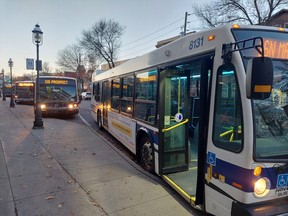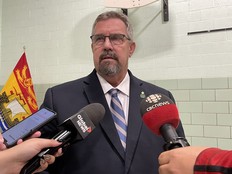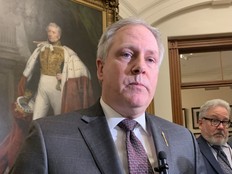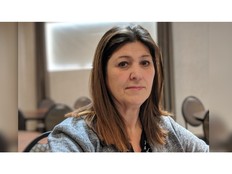Inconvenience is public transit's dead end: critics
Advocates say people won't ditch their cars, SUVs and light trucks until public transit becomes far more convenient, with more routes and frequent service

Article content
Moe Qureshi wanted to take the bus on his first day of work in Fredericton, just like he would in Mississauga, the city near Toronto where he grew up.
The trip on that March day from his home to his downtown office across the river at the Conservation Council of New Brunswick should have only taken a few minutes.
“I didn’t want to drive because I heard it was pretty close,” he said. “So I looked at the map on my phone, and it said it was a half hour walk to get to the office. And then I clicked on the bus, and it said it was a half hour wait till the next bus.
“So I just walked to work and got there way faster.”
The council’s manager of climate solutions, Qureshi preaches the importance of reducing greenhouse gas emissions to save the planet every day. And he knows a big part of that is changing Canada’s car culture.
But he also sees what’s standing in the way for him and tens of thousands of New Brunswickers from taking a less polluting form of transportation.
“I would take the bus if it were convenient, but it’s just not,” he said. “And the sad part is now I’m driving to work. It’s a bit cold and that bridge, with the wind, is unforgiving.”
A national problem
Another green organization similar to his own has spelled out the challenge. Environmental Defence says the biggest roadblock in getting people out of their cars and into public transit is the inconvenience factor.
There just isn’t enough bus service in smaller Canadian cities and towns to make it easy for people to leave their own vehicles behind.
And that comes at a cost. Filling a bus with passengers is the equivalent of removing 40 cars from the road and uses two-thirds less fuel.
Environmental Defence points out that if Ottawa is serious about its plan to get more polluting cars, SUVs and light trucks off the road – the Trudeau government has mandated that all new vehicle sales be electric only by 2035 – it also has to work awfully hard over the short term to eliminate automobiles and light trucks that still use gasoline. They cause 11 per cent of Canada’s total greenhouse gas emissions.
The solution, it says, is for Ottawa and provincial governments to contribute funding for running public transit. As it stands, New Brunswick transit systems count on their city governments and the fare box to provide all their operational funds.
The Trudeau Liberals have created several expensive programs to help communities with capital upgrades, such as buying electric buses and putting in light rail.
This includes spending $13 billion on 1,300 projects across the country from 2015 to 2021.
Two years ago, they announced an additional $14.9 billion for such projects over eight years. Part of it included what they called permanent annual funding of $3 billion, starting in 2026, for capital upgrades to transit.
And yet, no money has been committed to actually run those expensive, non-emitting new buses and trains.
Brunswick News asked for an interview with federal infrastructure minister Sean Fraser, who is from Nova Scotia, about the paradox, but he was not made available.
Instead, Micaal Ahmed, a spokesperson for his office, sent a prepared statement that didn’t address the question about operational funding.
“As a government, we know that investing in public transit shortens commute times for families, creates good jobs for the middle class, grows our economy, and helps combat climate change,” he wrote. “Our contribution of more than $3.6 million through the Public Transit Infrastructure Fund for the purchase of 12 low-floor, low-emission buses, for Saint John Transit is an example of our commitment.”
Ahmed added that the launch of the permanent transit fund in three years would provide stable funding so that communities “can build and expand their transit systems.”
The car remains king
Environmental Defence says other countries with excellent public transit either have national governments that provide operational funds or allow municipalities greater taxation powers to fund their bus, light rail, subway and streetcar services.
For people in these places, taking transit is cheaper and much more convenient than owning a car.
“You can’t expand service simply by buying more buses,” the organization’s Nate Wallace warned in a blog post earlier this year. “It also takes a driver to put that bus into service, and that takes operations funding. With operations funding, bus transit service can scale up quickly at the pace we need to meet our 2030 climate targets.”
Public transit in New Brunswick remains spotty, despite recent improvements and more ridership. The car remains king. It isn’t unusual at rush hour in Fredericton to see gridlock all the way up Smythe Street or Main Street. The same is true on Vaughan Harvey Boulevard or the Gunningsville Bridge in Moncton, or Route 1 or Westmorland Road in Saint John. Many of the passenger vehicles in a long line have only one person inside, sitting impatiently, waiting to move.
A surge in ridership
Transit managers for the three cities agree that more funding would help them offer more frequent service and more routes, convincing more people to leave a vehicle at home.
Ian MacKinnon, Saint John’s director of transit and fleet services, says his bus service is catching up to its pre-COVID passenger levels of 1.8 million rides a year and expects to surpass it within the first few months of 2024.
And the manager is excited by a new on-demand service introduced in January that allows people in the city outskirts without regular bus service to order a smaller, electric bus to get from point to point by using an app or making a phone call.
But like other small transit systems, it is caught in a catch-22. If Saint John Transit raises fares too much, it will lose customers, he says. But without more money, it’s difficult, if not impossible, to increase service.
“The federal funding to buy buses was great,” MacKinnon said. “One of the things, though, that remains a challenge is operational dollars. Historically, the federal funding has only been capital with no dollars for operational costs. Transit systems like ours are always challenged when it comes to operational funding. If you want to build a robust transit system, you would need more operational dollars, for sure.”
The greater Moncton area has seen a surge in people who want to take the bus, driven by more immigrants and university and college students.
It’s like a rubber band. We try to make tweaks in lots of places, but you can only stretch it so much or one day that rubber band will break.
Alex Grncarovski
Alex Grncarovski, operations manager at Codiac Transpo, says the service will likely have a record number of passengers by year-end, just below two million trips.
“We only have so many buses and so many hours of service, and everyone is asking us to serve their areas,” the manager said. “If you look at all the apartments and condominiums going up, many of these people need transit. One of the greatest demands is in the northwest end of the city. We’d like to put some service up there, but because of the lack of funding, we are really stretched to the limit.”
Grncarovski was thankful Ottawa had promised to spend billions of dollars more on buses. But he said any funds to also help run the service would get Codiac Transit to the next level.
“It’s a good news story: We’re growing, and ridership numbers are getting stronger. But it’s like a rubber band. We try to make tweaks in lots of places, but you can only stretch it so much or one day that rubber band will break.”
A transit manager’s dilemma
Following years of complaints, Fredericton Transit has finally presented a plan to city council that would introduce Sunday bus service. But it requires raising fares from $2.75 to $3, a move that could impact overall ridership.
Charlene Sharpe, the manager of the service, said she was very pleased to see the Fredericton Chamber of Commerce take a leadership role in lobbying Ottawa for operational funding of public transit, particularly in smaller cities.
At the Canadian Chamber of Commerce’s annual general meeting in Calgary last month, it convinced other city chambers to support its resolution asking Ottawa to “adjust federal public transportation funding formulas to provide smaller and rural communities with support to expand operational services and a base funding amount that encourages communities with low ridership and population density to invest in operational and capital upgrades.”
“It’s phenomenal,” said Sharpe, who expects her transit system to register about two million rides this year. “That’s the message most public transit agencies have come forward with, particularly the smaller ones, that they’re trying to get more funds from an operating perspective, to help support growth.”
Morgan Peters, the incoming CEO of the local chamber, said his organization made the resolution a priority because many businesses had mentioned that transit was essential for getting their employees to work and their customers to stores. Passed with the support of 92 per cent of delegates, it means that the national organization will make the resolution a priority for the next three years in discussions with Ottawa.
Sharpe’s organization last year used federal and municipal funding of $1.1 million in part to buy technology that would provide the data to know exactly where service is most needed. The automatic passenger readers track exactly where people get on and off buses and at what times, a program that started in earnest in April and will take at least a year to provide comprehensive data.
But once Fredericton Transit has the information, there’s no guarantee there will be money available to improve service significantly by offering more frequent runs.
“I’d like to see any opportunity for more funding so that we can better support the community and make it more convenient for people to consider transit,” Sharpe said.
Planning your life around the bus
Qureshi hopes those improvements come soon.
He’d love to hop on a bus to work or on a Saturday night to go out with friends.
“They go hand in hand, capital and operational costs. You need the bus drivers on the road to make public transit convenient,” he said. “In bigger Canadian cities or Europe, public transit doesn’t change your day or your plans. In Fredericton, you have to schedule your day around the bus. That’s not how people want to live their life. You want to come and go as you please, and that’s what a car gives you. The only way you’ll get people to stop using cars is to offer that same convenience.”












Postmedia is committed to maintaining a lively but civil forum for discussion. Please keep comments relevant and respectful. Comments may take up to an hour to appear on the site. You will receive an email if there is a reply to your comment, an update to a thread you follow or if a user you follow comments. Visit our Community Guidelines for more information.